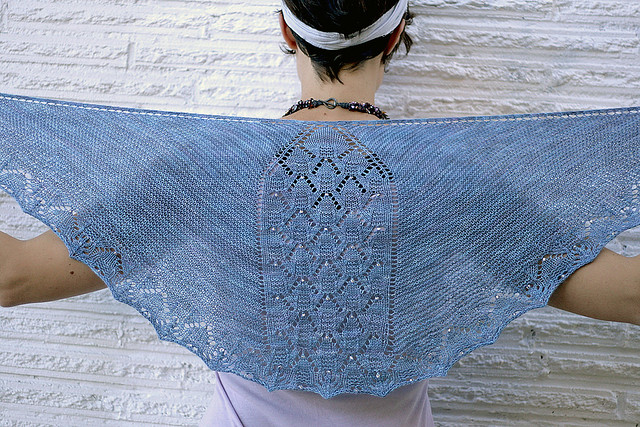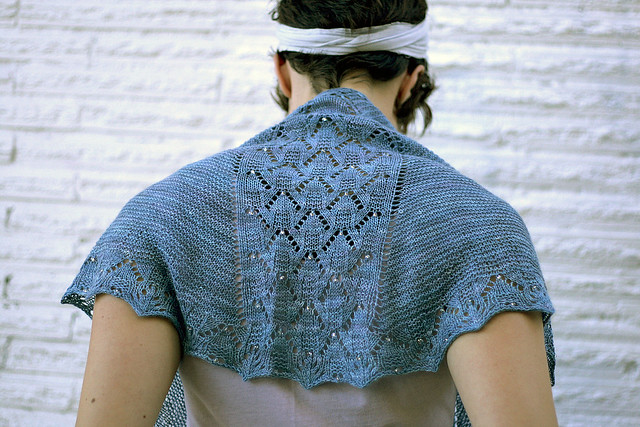
Confluence is a sweet little shawlette, a play on my favorite theme of a center panel with neck shaping inserted into a top down triangle shawl. It is mostly garter stitch, which is so pleasing, except for the lace panel which is stockinette lace with a few well chosen beads. Simple and charming.
I promised a release a couple of days ago. Obviously, Confluence is not out yet, and for a good reason.
For a good while now, I have been receiving occasional letters from sight impaired knitters who thank me for taking the time to write out line by line instructions in my patterns.
If you think about it, it makes perfect sense that sight impaired or blind knitters would need written instructions in order to knit lace, or to knit anything for that matter. As I understand it, there are readers available on many computers for this purpose, and if not, some knitters will engage sighted people to read the pattern to them as they knit, or record the pattern instructions for later playback, an ingenious idea! I am reminded of Lucy Neatby's recent writing about how hard it is to keep your attention where it belongs, on your knitting, while at the same time trying to focus your eyes on multiple things (chart, pattern, knitting) and all the while, manage to knit a complicated pattern. Lucy recommends recording yourself reading the lines of the pattern instruction at the speed you like to knit so you can keep your eyes and your attention on your knitting. Brilliant.
Anyway, when I get a letter of this sort from a knitter I generally respond with apologies that not EVERY pattern can be written out line by line. And this is true.. Shetland Garden, for instance, would be a book-length pattern if it had written instructions. But these communications give me a good kind of reboot as I consider what the world would be like without all different sorts of knitters with all the different life experiences we bring to the craft.
It still blows me away that there are blind and sight impaired lace knitters out there. If you are one of those brave and fearless knitters, I bow my deepest, most humble bow to you.
As much as I love knitting from charts, and as many times as I have cajoled and begged and even ordered my students to knit from charts, all of that pales in the face of knitterly courage that will not accept limitations.
So, come time to release a new pattern, I must assess whether to bite the proverbial bullet and write everything out "longhand" as well as provide charts. Sometimes, like for Shetland Garden, I feel it would confuse and not enlighten, so it is left out. Sometimes it is the right thing to write it out.. and then there is always the worry that with more words on the pages, there are more possibilities for published errors, every designer's nightmare.
All this is by way of explanation of the lateness of Confluence's publication. I promised it would be out two days ago, but here I am. I hope the new written instructions will be worth the wait for those who need them in order to knit.
Saturday, September 11, 2010
The Confluence of Ideas
Posted by
Unknown
at
8:07 AM
![]()
Labels: beads, knitting, life changes, new patterns, shawls
Subscribe to:
Post Comments (Atom)



10 comments:
What a gracious idea. Charts can be tricky, even for the sighted. We don't do ourselves favours by squeezing in television or reading at the same time. Sometimes even an audio book is too much fracture of focus.
I inted to drop that type of multitasking for this weekend and knit to my favourite: Bach.
Thank you, LoriAngela, and I so agree, although audiobooks and movies are tempting. Bach is undoubtedly better for the mind AND the soul.
This shawlette is simply beautiful. Want, want, want! And I could spin enough to do it, too...
Great idea! My mom is blind and we are always looking for helpful things for her.
What a lovely shawlette - I love its simple elegance. I think it's wonderful that you are taking the time to write the pattern so that our sight-impaired friends can also enjoy your design.
So pretty!
There was a blind woman in the knitting group that used to meet at my LYS. She was amazing ~ knitted the most incredible cabled aran sweaters, and intricate lace ... she'd get her patterns transcribed into braille or audio, and memorize two lines of pattern at a time.
And watching her fix mistakes (mostly in other people's knitting ... she rarely made mistakes in her own) was even more incredible.
Cudos to you for making your patterns as accessible as possible :-D
How thoughtfully considered and eloquently said. I admire your drive to make your patterns available to all.
So beautiful! And I'm sure it will be worth the wait.
Hi, I'm not blind or sight impaired - I do wear trifocals though. But, it's still difficult for me to follow a chart UNLESS I do one or more of the following after I make a copy.
Enlarge the chart - my little computer printer enlarges and it is at least 5 years old.
Below the row I am knitting, paperclip with the long paperclips a long white envelope. For some patterns, I use an envelope that I have cut a narrow strip from first.
Cut each individual line and glue stick each to a separate 3by5 card - number the cards first.
When the pattern says, for example, do row 1 of chart A, then row 3 of chart B, then row 1 of chart C, then row 1 of chart A, I make multiple copies first, then cut and glue together each chart piece into one long strip. When I have the written out instructions, I retype the instructions, so each row has ALL the directions for that row typed all together. It makes it so much easier and faster to knit a complicated pattern when you do this first.
Great reading your ppost
Post a Comment